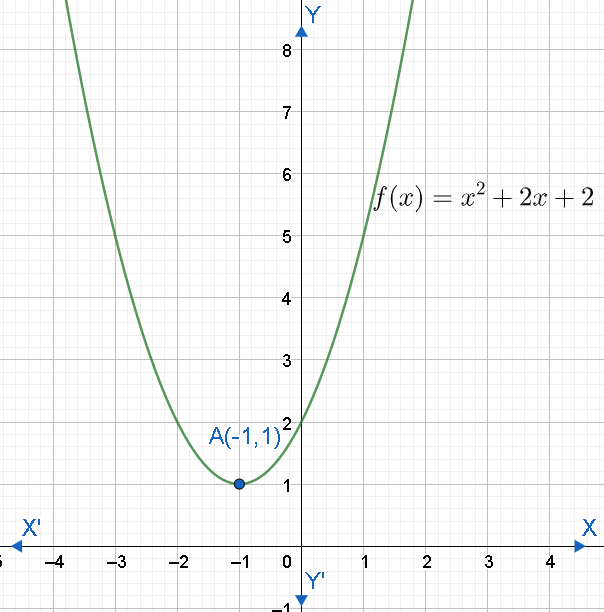
What is the range of the function $f\left( x \right)={{x}^{2}}+2x+2$ ?
Answer
507.9k+ views
Hint: To find the range of the function $f\left( x \right)={{x}^{2}}+2x+2$ , we have to rewrite this equation by splitting the constant as combining the terms. We will obtain $\Rightarrow f\left( x \right)=\left( {{x}^{2}}+2x+1 \right)+1$ . Now, we have to use the algebraic identity to get the result $f\left( x \right)={{\left( x+1 \right)}^{2}}+1$ . Now, we have to consider ${{\left( x+1 \right)}^{2}}$ , which will always be positive. Now, we have to make an inequality whose RHS will be the RHS of the function $f\left( x \right)$ . From this inequality, we can find the range of the given function.
Complete step-by-step answer:
We have to find the range of the function $f\left( x \right)={{x}^{2}}+2x+2$ . Let us first split the constant as $1+1$ .
$\Rightarrow f\left( x \right)={{x}^{2}}+2x+1+1$
We can group the terms as follows.
$\Rightarrow f\left( x \right)=\left( {{x}^{2}}+2x+1 \right)+1$
We can see that the terms inside the parenthesis is of the form ${{a}^{2}}+2ab+{{b}^{2}}={{\left( a+b \right)}^{2}}$ , where $a=1$ and $b=1$ . Hence, we can write the above equation as
$\Rightarrow f\left( x \right)={{\left( x+1 \right)}^{2}}+1...\left( i \right)$
We know that ${{\left( x+1 \right)}^{2}}$ will always be positive, that is, greater than or equal to 0, for all $x\in \mathbb{R}$ .
$\Rightarrow {{\left( x+1 \right)}^{2}}\ge 0$
Let us add 1 to both the sides to make the LHS of the above equation similar to equation (i).
$\begin{align}
& \Rightarrow {{\left( x+1 \right)}^{2}}+1\ge 0+1 \\
& \Rightarrow {{\left( x+1 \right)}^{2}}+1\ge 1...\left( ii \right) \\
\end{align}$
We know that the range of a function is the spread of possible y-values (minimum y-value to maximum y-value). Hence, we can write the range of the given function from (ii) as
$y\in \left[ 1,\infty \right)$
Therefore, the range of the function $f\left( x \right)={{x}^{2}}+2x+2$ is $\left[ 1,\infty \right)$ .
Note: Students must know algebraic identities to simplify the equations. We have used a closed interval in the range for 1 and open interval for 0 because from the inequality (ii), we obtained a $\ge $ sign. We can also find the range by substituting different real numbers for x and computing the corresponding y values ( f(x) ). We can then interpret the range from the values of y or from the graph. Let us see the graph of the function $f\left( x \right)={{x}^{2}}+2x+2$ , which is a parabola.

We can see that the minimum value of y is -1 and maximum value is infinity.
Complete step-by-step answer:
We have to find the range of the function $f\left( x \right)={{x}^{2}}+2x+2$ . Let us first split the constant as $1+1$ .
$\Rightarrow f\left( x \right)={{x}^{2}}+2x+1+1$
We can group the terms as follows.
$\Rightarrow f\left( x \right)=\left( {{x}^{2}}+2x+1 \right)+1$
We can see that the terms inside the parenthesis is of the form ${{a}^{2}}+2ab+{{b}^{2}}={{\left( a+b \right)}^{2}}$ , where $a=1$ and $b=1$ . Hence, we can write the above equation as
$\Rightarrow f\left( x \right)={{\left( x+1 \right)}^{2}}+1...\left( i \right)$
We know that ${{\left( x+1 \right)}^{2}}$ will always be positive, that is, greater than or equal to 0, for all $x\in \mathbb{R}$ .
$\Rightarrow {{\left( x+1 \right)}^{2}}\ge 0$
Let us add 1 to both the sides to make the LHS of the above equation similar to equation (i).
$\begin{align}
& \Rightarrow {{\left( x+1 \right)}^{2}}+1\ge 0+1 \\
& \Rightarrow {{\left( x+1 \right)}^{2}}+1\ge 1...\left( ii \right) \\
\end{align}$
We know that the range of a function is the spread of possible y-values (minimum y-value to maximum y-value). Hence, we can write the range of the given function from (ii) as
$y\in \left[ 1,\infty \right)$
Therefore, the range of the function $f\left( x \right)={{x}^{2}}+2x+2$ is $\left[ 1,\infty \right)$ .
Note: Students must know algebraic identities to simplify the equations. We have used a closed interval in the range for 1 and open interval for 0 because from the inequality (ii), we obtained a $\ge $ sign. We can also find the range by substituting different real numbers for x and computing the corresponding y values ( f(x) ). We can then interpret the range from the values of y or from the graph. Let us see the graph of the function $f\left( x \right)={{x}^{2}}+2x+2$ , which is a parabola.

We can see that the minimum value of y is -1 and maximum value is infinity.
Recently Updated Pages
Master Class 12 Business Studies: Engaging Questions & Answers for Success

Master Class 12 Economics: Engaging Questions & Answers for Success

Master Class 12 English: Engaging Questions & Answers for Success

Master Class 12 Maths: Engaging Questions & Answers for Success

Master Class 12 Social Science: Engaging Questions & Answers for Success

Master Class 12 Chemistry: Engaging Questions & Answers for Success

Trending doubts
What is meant by exothermic and endothermic reactions class 11 chemistry CBSE

Which animal has three hearts class 11 biology CBSE

10 examples of friction in our daily life

One Metric ton is equal to kg A 10000 B 1000 C 100 class 11 physics CBSE

1 Quintal is equal to a 110 kg b 10 kg c 100kg d 1000 class 11 physics CBSE

Difference Between Prokaryotic Cells and Eukaryotic Cells




